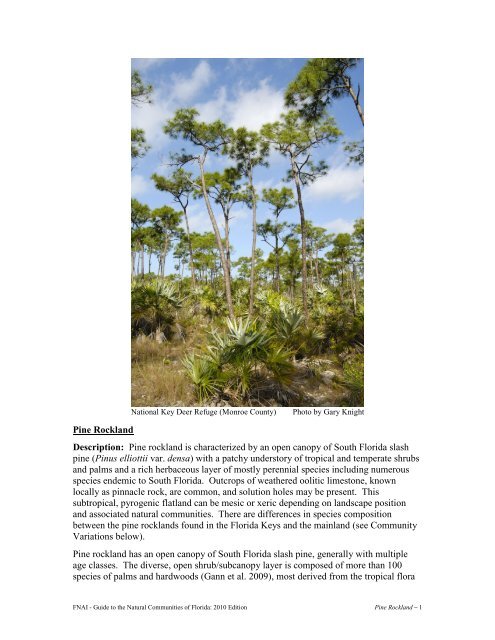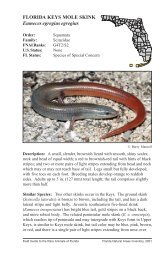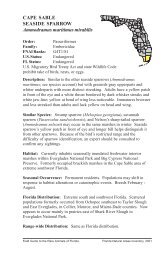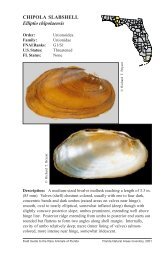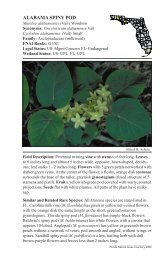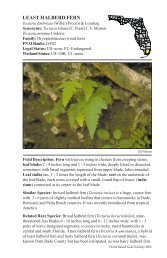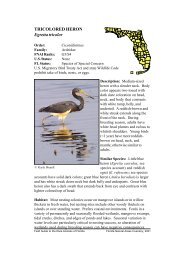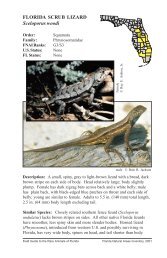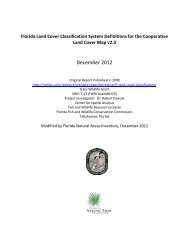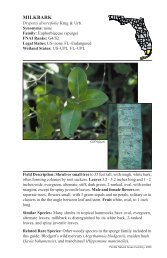pine rocklands(pdf) - Florida Natural Areas Inventory
pine rocklands(pdf) - Florida Natural Areas Inventory
pine rocklands(pdf) - Florida Natural Areas Inventory
You also want an ePaper? Increase the reach of your titles
YUMPU automatically turns print PDFs into web optimized ePapers that Google loves.
National Key Deer Refuge (Monroe County)<br />
Photo by Gary Knight<br />
Pine Rockland<br />
Description: Pine rockland is characterized by an open canopy of South <strong>Florida</strong> slash<br />
<strong>pine</strong> (Pinus elliottii var. densa) with a patchy understory of tropical and temperate shrubs<br />
and palms and a rich herbaceous layer of mostly perennial species including numerous<br />
species endemic to South <strong>Florida</strong>. Outcrops of weathered oolitic limestone, known<br />
locally as pinnacle rock, are common, and solution holes may be present. This<br />
subtropical, pyrogenic flatland can be mesic or xeric depending on landscape position<br />
and associated natural communities. There are differences in species composition<br />
between the <strong>pine</strong> <strong>rocklands</strong> found in the <strong>Florida</strong> Keys and the mainland (see Community<br />
Variations below).<br />
Pine rockland has an open canopy of South <strong>Florida</strong> slash <strong>pine</strong>, generally with multiple<br />
age classes. The diverse, open shrub/subcanopy layer is composed of more than 100<br />
species of palms and hardwoods (Gann et al. 2009), most derived from the tropical flora<br />
FNAI - Guide to the <strong>Natural</strong> Communities of <strong>Florida</strong>: 2010 Edition Pine Rockland – 1
of the West Indies (Snyder et al. 1990). Many of these species vary in height depending<br />
on fire frequency, getting taller with time since fire. These include saw palmetto<br />
(Serenoa repens), cabbage palm (Sabal palmetto), silver palm (Coccothrinax argentata),<br />
brittle thatch palm (Thrinax morrisii), wax myrtle (Myrica cerifera), myrsine (Rapanea<br />
punctata), poisonwood (Metopium toxiferum), locustberry (Byrsonima lucida),<br />
varnishleaf (Dodonaea viscosa), tetrazygia (Tetrazygia bicolor), rough velvetseed<br />
(Guettarda scabra), marlberry (Ardisia escallonioides), mangrove berry (Psidium<br />
longipes), willow bustic (Sideroxylon salicifolium), winged sumac (Rhus copallinum).<br />
Short-statured shrubs include running oak (Quercus elliottii), white indigoberry (Randia<br />
aculeata), Christmas berry (Crossopetalum ilicifolium), redgal (Morinda royoc), and<br />
snowberry (Chiococca alba). Grasses, forbs, and ferns make up a diverse herbaceous<br />
layer ranging from mostly continuous in areas with more soil development and little<br />
exposed rock to sparse where more extensive outcroppings of rock occur. Typical<br />
herbaceous species include bluestems (Andropogon spp.), several species of bluestem<br />
(Schizachyrium gracile, S. rhizomatum, and S. sanguineum), arrowleaf threeawn (Aristida<br />
purpurascens), lopsided indiangrass (Sorghastrum secundum), hairawn muhly<br />
(Muhlenbergia capillaris), <strong>Florida</strong> white-top sedge (Rhynchospora floridensis), <strong>pine</strong>land<br />
noseburn (Tragia saxicola), devil’s potato (Echites umbellata), <strong>pine</strong>land croton (Croton<br />
linearis), several species of sandmats (Chamaesyce spp.), partridge pea (Chamaecrista<br />
fasciculata), coontie (Zamia pumila), maidenhair <strong>pine</strong>land fern (Anemia adiantifolia),<br />
Bahama brake (Pteris bahamensis), and lacy bracken (Pteridium aquilinum var.<br />
caudatum).<br />
Pine rockland occurs on relatively flat, moderately to well drained terrain from two to<br />
seven meters above sea level (Snyder et al. 1990). The oolitic limestone is at or very near<br />
the surface, and there is very little soil development. Soils are generally composed of<br />
small accumulations of nutrient-poor sand, marl, clayey loam, and organic debris in<br />
depressions and crevices in the rock surface. Organic acids occasionally dissolve the<br />
surface limestone causing collapsed depressions in the surface rock called solution holes<br />
(Outcalt 1997). Drainage varies according to the porosity of the limestone substrate, but<br />
is generally rapid. Consequently, most sites are wet for only short periods following<br />
heavy rains. During the rainy season, however, some sites may be shallowly inundated<br />
by slow-flowing surface water for up to 60 days each year.<br />
Characteristic Set of Species: South <strong>Florida</strong> slash <strong>pine</strong>, Christmas berry, maidenhair<br />
<strong>pine</strong>land fern, <strong>Florida</strong> silver palm, <strong>Florida</strong> white-top sedge<br />
Rare Species: Pine <strong>rocklands</strong> are rich with rare and endemic plants (Table 1).<br />
Numerous plants endemic to South <strong>Florida</strong> are found in <strong>pine</strong> rockland, including 18<br />
species that are restricted to this community such as Carter’s small-flowered flax (Linum<br />
carteri var. carteri; Bradley and Gann 1999). Some rare plant species of <strong>pine</strong> <strong>rocklands</strong><br />
occur throughout the range of <strong>pine</strong> rockland, such as <strong>pine</strong>land noseburn and Christmas<br />
berry, while other species such as Big Pine partridge pea (Chamaecrista lineata var.<br />
keyensis) and few-flowered fingergrass (Digitaria pauciflora) have more restricted<br />
distributions (Table 1).<br />
Five federally listed animals, <strong>Florida</strong> panther (Puma concolor coryi), key deer<br />
(Odocoileus virginianus clavium), key rice rat (Oryzomys palustris pop. 1), eastern indigo<br />
FNAI - Guide to the <strong>Natural</strong> Communities of <strong>Florida</strong>: 2010 Edition Pine Rockland – 2
snake (Drymarchon couperi), key ringneck snake (Diadophis punctatus acricus), and<br />
lower keys rabbit (Sylvilagus palustris hefneri), use <strong>pine</strong> <strong>rocklands</strong> either for foraging or<br />
nesting (Bradley and Gann 1999). Pine <strong>rocklands</strong> are particularly important foraging<br />
habitat for key deer (Carlson et al. 1993). <strong>Florida</strong> leafwing (Anaea troglodyta floridalis),<br />
lesser wasp moth (Pseudocharis minima), Bartram’s scrub-hairstreak (Strymon acis<br />
bartrami), and two species of rare katydid (Belocephalus micanopy and Belocephalus<br />
sleighti) are among the many rare invertebrates found in <strong>pine</strong> rockland.<br />
Range: Pine rockland is globally imperiled and extremely limited in distribution. In<br />
<strong>Florida</strong>, <strong>pine</strong> rockland occurs along the southern extreme of the Atlantic Coastal Ridge,<br />
or the Miami Rock Ridge, which extends from around downtown Miami southwest to<br />
Long Pine Key in Everglades National Park (Miami-Dade County); in scattered locations<br />
in the lower <strong>Florida</strong> Keys, most notably and extensively on Big Pine Key (Monroe<br />
County); and in a small isolated area in the Big Cypress National Preserve (Monroe and<br />
Collier counties). Pine rockland historically occurred in the upper <strong>Florida</strong> Keys; <strong>pine</strong><br />
stumps and remnant species characteristic of <strong>pine</strong> rockland have been found in one area<br />
of Key Largo (Alexander 1953).<br />
Similar physiognomic <strong>pine</strong>lands occur in the Caribbean, particularly in the eastern<br />
Bahama Archipelago on Grand Bahama, Abaco, New Providence, and Andros, with<br />
disjunct <strong>pine</strong>lands in the Caicos Islands (Correll and Correll 1982). These communities,<br />
while dominated by Caribbean <strong>pine</strong> (Pinus caribaea), are otherwise quite similar in<br />
species composition to <strong>Florida</strong> <strong>pine</strong> rockland (Correll and Correll 1982).<br />
Urban development and agriculture have greatly reduced the extent of <strong>pine</strong> rockland.<br />
The condition of some extant <strong>pine</strong> <strong>rocklands</strong> has declined because of inadequate<br />
management or because they are isolated and confined by surrounding development that<br />
restricts the use of prescribed fire, a principal management tool. Everglades National<br />
Park supports 80 percent of <strong>Florida</strong>’s remaining <strong>pine</strong> <strong>rocklands</strong> in <strong>Florida</strong> (Loope et al.<br />
1979). Only about two percent (2,273 acres) of the original Miami-Dade County <strong>pine</strong><br />
rockland (approximately 126,500 acres) remains outside Everglades National Park (URS<br />
Corporation Southern et al. 2007).<br />
<strong>Natural</strong> Processes: Pine rockland is maintained by regular fire, and susceptible to other<br />
natural disturbances such as hurricanes, frost events, and sea-level rise (Ross et al. 1994).<br />
Fires historically burned on an interval of around 3 to 7 years (Wade et al. 1980; Snyder<br />
et al. 1990; URS Corporation Southern et al. 2007) and was typically started by lightning<br />
strikes during the frequent summer thunderstorms.<br />
Presently, prescribed fire must be periodically introduced into <strong>pine</strong> <strong>rocklands</strong> to sustain<br />
community structure, prevent invasion by woody species, maintain high herbaceous<br />
diversity (Loope and Dunevitz 1981), and prevent succession to rockland hammock. The<br />
degree of woody understory growth is directly related to the length of time since the last<br />
fire. The ecotone between <strong>pine</strong> rockland and rockland hammock is abrupt when regular<br />
fire is present in the system. However when fire is removed the ecotone becomes more<br />
gradual and subtle as hammock hardwoods encroach into the <strong>pine</strong>land (Wade et al.<br />
1980).<br />
FNAI - Guide to the <strong>Natural</strong> Communities of <strong>Florida</strong>: 2010 Edition Pine Rockland – 3
Hurricanes and storms can have a major impact on <strong>pine</strong> <strong>rocklands</strong>. High winds can<br />
significantly affect plant structure or composition by causing canopy and subcanopy<br />
mortality (Platt et al. 2000), resulting in subsequent stimulation of shrub or herbaceous<br />
growth. Pine <strong>rocklands</strong> near the coast may be temporarily inundated by saltwater during<br />
severe storm events which can kill or damage vegetation (Snyder et al. 1990; URS<br />
Corporation Southern et al. 2007). Rare frost events bringing below-freezing<br />
temperatures can reduce tropical hardwoods. Because tropical and subtropical plants in<br />
<strong>pine</strong> <strong>rocklands</strong> are more exposed to below-freezing temperatures in the relatively open<br />
understory, they are more likely to succumb to freeze damage than their counterparts in<br />
sheltered rockland hammocks. The area of <strong>pine</strong> rockland in the <strong>Florida</strong> Keys has been<br />
reduced since the 1930s (Ross et al. 1994). This is at least partially due to increased<br />
ground and soil salinity resulting from a 15 centimeters local rise in sea-level that has<br />
occurred since that time (Ross et al. 1994).<br />
Community Variations: Pine rockland occurs in three distinct areas: the Miami Rock<br />
Ridge, the <strong>Florida</strong> Keys, and the Big Cypress area. The woody understory varies across<br />
this range. Big Cypress <strong>pine</strong> rockland contains more temperate species and is generally<br />
wetter than <strong>pine</strong> rockland on the Miami Rock Ridge or <strong>Florida</strong> Keys (Snyder et al. 1990).<br />
The <strong>Florida</strong> Keys <strong>pine</strong> rockland is more xeric due to lower rainfall and has a well<br />
developed subcanopy of silver palm, brittle thatch palm, and a higher percentage of<br />
tropical shrub species since many temperate species, such as running oak and coontie,<br />
reach their southern limits on the mainland. Many tropical shrub species such as devil’s<br />
smooth-claw (Pisonia rotundata) do not extend to the mainland. The mainland <strong>pine</strong><br />
rockland has a more diverse herbaceous layer due to a mixture of temperate species that<br />
do not reach the <strong>Florida</strong> Keys and tropical species not present in the <strong>Florida</strong> Keys such as<br />
tetrazygia.<br />
Associated Communities: Pine rockland occurs mainly in a mosaic with two other<br />
natural community types: rockland hammock and marl prairie. Pine rockland grades into<br />
and, in the absence of fire, succeeds to rockland hammock. Many species occur in both<br />
habitats; these include locustberry, <strong>Florida</strong> thatch palm, and poisonwood. Pine rockland<br />
differs from rockland hammock in having an open <strong>pine</strong> canopy rather than a closed,<br />
hardwood canopy. Pine rockland can also occur within lower, seasonally flooded marl<br />
prairies on the Miami Rock Ridge. These marl prairies differ from <strong>pine</strong> rockland in<br />
having no <strong>pine</strong>s, and an understory dominated by grasses and sedges, typically hairawn<br />
muhly (Muhlenbergia capillaris) and sawgrass (Cladium jamaicense), and a minimal<br />
cover of shrubs. In areas where <strong>pine</strong> rockland is close to the ocean it may be bordered by<br />
mangrove swamp or salt marsh and can receive flooding by extremely high tides.<br />
Pine <strong>rocklands</strong> on the northern Miami Rock Ridge grade into scrub and sandhill<br />
vegetation where the three communities intermix in areas with deep sands and rock<br />
outcrops (Snyder et al. 1990). On the northwestern edge of the <strong>pine</strong> rockland range, in<br />
Big Cypress National Preserve, <strong>pine</strong> <strong>rocklands</strong> occur in a mosaic with wet flatwoods.<br />
Pine <strong>rocklands</strong> can be distinguished from wet flatwoods, scrub, and sandhills by the<br />
presence of exposed limestone rock and the presence of rare plant species characteristic<br />
of <strong>pine</strong> rockland (Table 1).<br />
FNAI - Guide to the <strong>Natural</strong> Communities of <strong>Florida</strong>: 2010 Edition Pine Rockland – 4
Management Considerations: Prescribed fire is the most important consideration in<br />
<strong>pine</strong> rockland management and should be administered every 3 to 7 years to maintain<br />
community structure and to prevent the community from succeeding to rockland<br />
hammock. Although hardwood species are a natural component of <strong>pine</strong> rockland,<br />
without fire they tend to increase in cover and reduce the amount of light penetrating the<br />
forest floor (Wade et al. 1980). Over time, shading from hardwoods will reduce<br />
herbaceous diversity, and a period of just 10 years without fire may result in a marked<br />
decrease in number of herbaceous species. Exclusion of fire for 25 years will result in<br />
gradual hammock development over that time period, leaving a system that is very fire<br />
resistant (Robertson, Jr. 1953; Wade et al. 1980).<br />
Prescribed fire can be difficult to administer because of urban interface issues related to<br />
public perception and smoke management. Alternatives to prescribed fire, such as<br />
mechanical removal of woody vegetation are less ecologically effective, as they do not<br />
mimic post-fire nutrient cycling processes (URS Corporation Southern et al. 2007) and<br />
the woody debris generated must be removed to prevent organic soil development (URS<br />
Corporation Southern et al. 2007). Use of heavy equipment can damage soils and<br />
herbaceous vegetation, and large-scale removal of vegetation debris could inadvertently<br />
include removal of non-target species and propagules.<br />
Shading from and competition with invasive exotic plants for limited resources can be a<br />
problem in <strong>pine</strong> <strong>rocklands</strong>. Brazilian pepper (Schinus terebinthifolius), Burma reed<br />
(Neyraudia reynaudiana), natal grass (Melinis repens), and more than 100 other nonnative<br />
plant species have invaded many <strong>pine</strong> <strong>rocklands</strong> (Possley and Maschinski 2006;<br />
URS Corporation Southern et al. 2007). Prescribed fire, herbicide application, and<br />
manual removal are all useful tools to remove invasive exotic species. The fragmentation<br />
of <strong>pine</strong> rockland in the Miami area and the <strong>Florida</strong> Keys increases the risk of invasion by<br />
exotic plants along the interface with disturbed or developed areas.<br />
Exemplary Sites: Ludlam Pineland (Miami-Dade County), Navy Wells Park (Miami-<br />
Dade County), Long Pine Key in Everglades National Park (Miami-Dade County),<br />
National Key Deer Refuge on Big Pine Key (Monroe County)<br />
Global and State Rank: G1/S1<br />
Crosswalk and Synonyms:<br />
Kuchler 105/Mangrove<br />
16/Subtropical Pine Forest<br />
Davis<br />
3/Southern Slash Pine Forests<br />
1/Coastal Strand<br />
SCS<br />
2/South <strong>Florida</strong> Coastal Strand<br />
9/Everglades Flatwoods<br />
Myers and Ewel Subtropical Forests - subtropical <strong>pine</strong>lands<br />
SAF<br />
111/South <strong>Florida</strong> Slash Pine<br />
74/Cabbage palmetto<br />
FLUCCS 411/Pine Flatwoods<br />
419/Other Pines<br />
FNAI - Guide to the <strong>Natural</strong> Communities of <strong>Florida</strong>: 2010 Edition Pine Rockland – 5
Table 1. Rare plant species (FNAI Tracked) in <strong>Florida</strong> <strong>pine</strong> rockland.<br />
Species Occurring on Both the Mainland Species Restricted to the Mainland<br />
and <strong>Florida</strong> Keys<br />
Argythamnia blodgettii<br />
Alvaradoa amorphoides<br />
Basiphyllaea corallicola<br />
Amorpha herbacea var. crenulata<br />
Bourreria cassinifolia<br />
Brickellia mosieri<br />
Byrsonima lucida<br />
Chamaesyce deltoidea ssp. adhaerens<br />
Chamaesyce garberi<br />
Chamaesyce deltoidea ssp. deltoidea<br />
Chamaesyce porteriana<br />
Chamaesyce deltoidea ssp. <strong>pine</strong>torum<br />
Coccothrinax argentata<br />
Colubrina cubensis var. floridana<br />
Crossopetalum ilicifolium<br />
Digitaria pauciflora<br />
Forestiera segregata var. <strong>pine</strong>torum<br />
Eupatorium villosum<br />
Hypelate trifolia<br />
Galactia <strong>pine</strong>torum<br />
Jacquemontia curtissii<br />
Galactia smallii<br />
Jacquinia keyensis<br />
Ilex krugiana<br />
Linum arenicola<br />
Ipomoea microdactyla<br />
Phyllanthus pentaphyllus var. floridanus Lantana depressa var. depressa<br />
Pteris bahamensis<br />
Linum carteri var. carteri<br />
Sachsia polycephala<br />
Linum carteri var. smallii<br />
Spiranthes torta<br />
Polygala smallii<br />
Stylosanthes calcicola<br />
Ponthieva brittoniae<br />
Thrinax morrisii<br />
Selaginella eatonii<br />
Tragia saxicola<br />
Tephrosia angustissima var. corallicola<br />
Tripsacum floridanum<br />
Species Restricted to the <strong>Florida</strong> Keys<br />
Caesalpinia pauciflora<br />
Catesbaea parviflora<br />
Chamaecrista lineata var. keyensis<br />
Chamaesyce deltoidea ssp. serpyllum<br />
Odontosoria clavata<br />
Pisonia rotundata<br />
Savia bahamensis<br />
Strumpfia maritima<br />
References:<br />
Alexander, T.R. 1953. Plant succession on Key Largo, <strong>Florida</strong>, involving Pinus caribaea<br />
and Quercus virginiana. <strong>Florida</strong> Academy of Sciences Quarterly Journal 16:133-<br />
138.<br />
Bradley, K., and G. Gann. 1999. The <strong>pine</strong> rockland forests of southern <strong>Florida</strong>. The<br />
Palmetto 19:12-19.<br />
FNAI - Guide to the <strong>Natural</strong> Communities of <strong>Florida</strong>: 2010 Edition Pine Rockland – 6
Carlson, P.C., G.W. Tanner, J.M. Wood, and S.R. Humphrey. 1993. Fire in key deer<br />
habitat improves browse, prevents succession, and preserves endemic herbs. The<br />
Journal of Wildlife Management 914-928.<br />
Correll, D.S., and H.B. Correll. 1982. Flora of the Bahama Archipelago. J. Cramer,<br />
Vaduz.<br />
Gann, G.D., K.A. Bradley, and S.W. Woodmansee. 2009. Floristic <strong>Inventory</strong> of South<br />
<strong>Florida</strong> Database. Institute for Regional Conservation. URL:<br />
http://regionalconservation.org/ircs/database/database.asp<br />
Loope, L.L., D.W. Black, S. Black, and G.N. Avery. 1979. Distribution and abundance of<br />
flora in limestone rockland <strong>pine</strong> forests of southeastern <strong>Florida</strong>. South <strong>Florida</strong><br />
Research Center, Everglades National Park, Homestead, <strong>Florida</strong>.<br />
Loope, L.L., and V.L. Dunevitz. 1981. Impact of fire exclusion and invasion of Schinus<br />
terebinthifolius on limestone rockland <strong>pine</strong> forests of southeastern <strong>Florida</strong>. Report<br />
T-645. South <strong>Florida</strong> Research Center, Everglades National Park, Homestead,<br />
<strong>Florida</strong>.<br />
Outcalt, K.W. 1997. An old-growth definition for tropical and subtropical forests in<br />
<strong>Florida</strong>. General Technical Report SRS-013. United States Department of<br />
Agriculture Forest Service, Southern Research Station, Asheville, North Carolina.<br />
Platt, W.J., R.F. Doren, and T.V. Armentano. 2000. Effects of Hurricane Andrew on<br />
stands of slash <strong>pine</strong> (Pinus elliottii var. densa) in the everglades region of south<br />
<strong>Florida</strong> (USA). Plant Ecology 146:43-60.<br />
Possley, J., and J. Maschinski. 2006. Competitive effects of the invasive grass<br />
Rhynchelytrum repens (Willd.) CE Hubb. on <strong>pine</strong> rockland vegetation. <strong>Natural</strong><br />
<strong>Areas</strong> Journal 26:391-395.<br />
Robertson, W.B., Jr. 1953. A survey of the effects of fire in Everglades National Park.<br />
United States Department of the Interior, National Park Service, Homestead,<br />
<strong>Florida</strong>.<br />
Ross, M.S., J.J. O'Brien, and L.d.S. Sternberg. 1994. Sea-level rise and the reduction in<br />
<strong>pine</strong> forests in the <strong>Florida</strong> Keys. Ecological Applications 4:144-156.<br />
Snyder, J.R., A. Herndon, and W.B. Robertson, Jr. 1990. South <strong>Florida</strong> rockland. Pages<br />
230-280 in R.L. Myers and J.J. Ewel, editors. Ecosystems of <strong>Florida</strong>. University<br />
of Central <strong>Florida</strong> Press, Orlando.<br />
URS Corporation Southern, Institute for Regional Conservation, and Muller and<br />
Associates, Inc. 2007. Miami-Dade County environmentally endangered lands<br />
program management plan, part II: management of specific habitat types. Chapter<br />
1: The <strong>pine</strong> rockland habitat. Miami-Dade County, Miami, <strong>Florida</strong>.<br />
FNAI - Guide to the <strong>Natural</strong> Communities of <strong>Florida</strong>: 2010 Edition Pine Rockland – 7
Wade, D., J. Ewel, and R. Hofstetter. 1980. Fire in South <strong>Florida</strong> ecosystems. Forest<br />
Service General Technical Report SE-17. Southeastern Forest Experiment Station,<br />
Asheville, North Carolina.<br />
Ludlam Pineland (Miami-Dade County)<br />
Photo by Gary Knight<br />
FNAI - Guide to the <strong>Natural</strong> Communities of <strong>Florida</strong>: 2010 Edition Pine Rockland – 8


